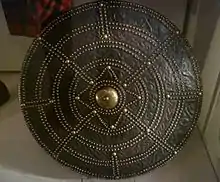Targe
Targe (from Old Franconian *targa "shield", Proto-Germanic *targo "border") was a general word for shield in late Old English. Its diminutive, target, came to mean an object to be aimed at in the 18th century.

The term refers to various types of shields used by infantry troops from the 13th to 16th centuries, or earlier.[1] More specifically, a targe was a concave shield fitted with enarmes on the inside, one adjustable by a buckle, to be attached to the forearm, and the other fixed as a grip for the left hand. These shields were mostly made of iron or iron-plated wood. From the 15th century, the term could also refer to special shields used for jousting. A fair number were created wholly for show.[2]
From the early 17th century, until the Battle of Culloden in 1746, the Scottish Highlander's main means of defence in battle was his targe. After the disastrous defeat of the Jacobites at Culloden, the carrying of the targe had been banned by the Disarming Act, and many were destroyed, or put to other uses. Those that remain have intricate patterns, and are decorated, indicating that they would have originally belonged to important people.
Structure of the Scottish targe

Targes are generally round shields between 18 in and 21 in (45–55 cm) in diameter. The inside of the targe was formed from two very thin layers of flat wooden boards, with the grain of each layer at right angles to the other. They were fixed together with small wooden pegs, forming plywood. The front was covered with a tough cowhide, which was often decorated with embossed Celtic style patterns. This was fixed to the wood with many brass, or in some cases, silver, nails, and occasionally brass plates were also fixed to the face for strength and decoration. Some targes had center bosses of brass, and a few of these could accept a long steel spike, which screwed into a small "puddle" of lead that was fixed to the wood, under the boss. When not in use, the spike could be unscrewed and placed in a sheath on the back of the targe. A Highlander was usually armed with a broadsword or dagger in one hand and a spiked targe on his other arm for close combat. It was also common for a dirk to be held in the targe hand, with the blade extending below the targe.
The back of the targe was commonly covered in deerskin, and a very few had some packing of straw etc. behind this. Some targes, usually those actually used in battle, had their backs covered in a piece of red cloth taken from the uniform of a British soldier (a "Redcoat") that the owner had killed in battle. Although all the old targes show signs of handles and arm straps, of various designs including centre-grips,[3] there is very little evidence to indicate that there was any guige strap for carrying the targe over the shoulder.
The face of a targe typically used two general patterns – concentric circles, or a centre boss with subsidiary bosses around this. There are a few notable exceptions, such as a targe in Perth Museum in Scotland that is of a star design. Although some targe designs appear to have been more popular than others, there is very little to indicate that there ever were "clan" designs (though every clansman would have had a heraldic coat of arms). The nearest that one might come to finding a "clan" design is four identical targes from the family armoury at Castle Grant. It appears more likely that targe designs were individual to their owner. During the 1745/46 Jacobite uprising, a William Lindsay, a shieldwright in Perth made hundreds of targes for Charles Edward Stuart's army. He made a distinction in price between an "officer's targe" and an ordinary targe.
See also
References
- Heath, Ian (1989). Armies of Feudal Europe 1066–1300. Wargames Research Group. ISBN 978-0-9044-1743-2.
- Walker, Paul F (2013). The History of Armour 1100–1700. Crowood Press. p. 121. ISBN 978-1-8479-7452-5.
- "Targes from Yetholm, Scottish Borders and County Limerick". Am Baile. Retrieved 2014-04-09.
External links
- Highland targes of the seventeenth and eighteenth centuries log-in requied
